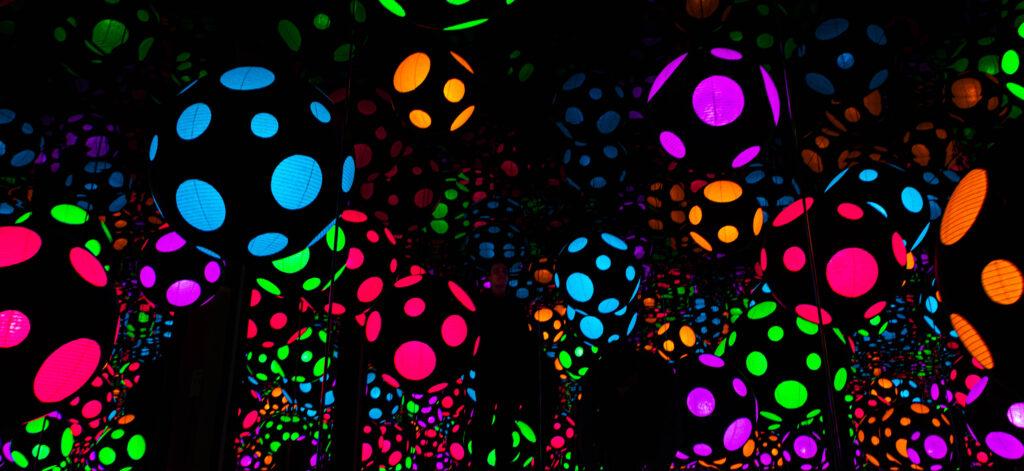★★★★★
Stepping into one of Yayoi Kusama’s immersive rooms feels like stepping into your own little infinity.
The “One with Eternity” exhibition at Washington, D.C.’s Hirshhorn Museum will continue to display photographs of Kusama along with her sculptures, two of her famous Infinity Mirror Rooms and an early painting until the spring of 2023. Kusama is a Japanese artist, best known for her enchanting, repetitive patterns, dream-like themes and use of mirrors to create a sense of infinity — even in confined spaces.
Though the exhibition is small, it gives visitors the perfect taste of Kusama’s memorable style, full of vibrant color and mesmerizing patterns. One of the sculptures, “Pumpkin,” features two of Kusama’s most recognizable motifs: pumpkins and repetitive dots.
The two Infinity Mirror Rooms on display — “Phalli’s Field” and “My Heart is Dancing into the Universe” — are her first and one of her most recent Mirror Rooms respectively, showing the evolution of her art.
These Infinity Mirror Rooms are small rooms with mirrored walls to give a sense of endlessness. Each room contains something different: “Phalli’s Field” is populated by stuffed, polka-dotted phalluses on the ground while the more psychedelic “My Heart is Dancing into the Universe” contains large paper lanterns that emanate color-changing light hung at different heights throughout the room.
The exhibition opens with a timeline and photos of Kusama’s life, offering context for her striking and eccentric art. From there, you enter a room painted orange and covered in polka dots with a giant sculpture of a pumpkin.
Pumpkins are featured in Kusama’s work throughout her career, and her affection for them is apparent in this room. “Pumpkin” stands tall and proud in the middle of the room, and the dots that run along its side form a clear pattern that contrasts the more random scatter of dots in the rest of the room, drawing the viewer’s eye to the pumpkin. However, the piece itself is lumpy and slightly imperfect. In drawing attention to the typically unpretentious pumpkin, Kusama encourages viewers to find beauty in their everyday lives.
After “Pumpkin,” you are guided to “Phalli’s Field.” The small room is surrounded by mirrors, and the floor is covered in hundreds of stuffed white phalluses of different sizes with red polka dots. The mirrors create an effect of a never-ending field of these phalluses.
Kusama herself was afraid of the idea of sex, and a large portion of her career was a form of “exposure therapy” to overcome her fear. The vibrant dots contrast with the sterile white of the phalluses, drawing the viewer’s eye to their different shapes and sizes. This evokes ideas about the natural and unique — and thus personal — nature of sex. Additionally, when looking in the mirror, you look like you are standing in the middle of this endless field, representing the continuous journey of human exploration of sex.
The last main room is “My Heart is Dancing into the Universe.” This room is larger and darker than the others, and the lanterns evoke images of stars and the universe. The mirror makes you feel like you are floating in space, and the changing colors remind the viewer of the constantly changing nature of the universe. On top of this, it is difficult to make out your own features in the mirrors. This forces the viewer to contemplate how light and beauty emanate from stars — a natural source — rather than artificial, human sources.
As you leave the exhibit, you see the final piece: “Flowers–Overcoat.” A monochromatic bronze coat covered in flowers hangs on a stark white wall, providing a space to absorb all of the bright patterns you just experienced. This piece also leaves you to contemplate the meaning of Kusama’s work and the contrasting colors, compared to the world of color that came before, as you exit the exhibition.
The exhibition is breathtaking but rather short. At Kusama’s request, viewers can only spend 30-60 seconds in the Infinity Mirror Rooms. However, this gives visitors enough time to examine her work and take photos, and the short time frame forces viewers to soak in the art while in the room and contemplate the meaning of her work after exiting.
Additionally, as there are only a total of five of Kusama’s pieces on display, the exhibition is brief. This brevity does not detract from the experience thanks to the wide range of media present and the exploration of her life, as well as the evolution of her art, present in the exhibition.
Kusama’s pieces are all unique and awe-inspiring, forcing viewers to contemplate everything from the exotic and imperfect pumpkin to the concept of sexuality and the idea of infinity. Her work reveals the infinite beauty of the world, taking viewers on a journey through her multifaceted thoughts.














